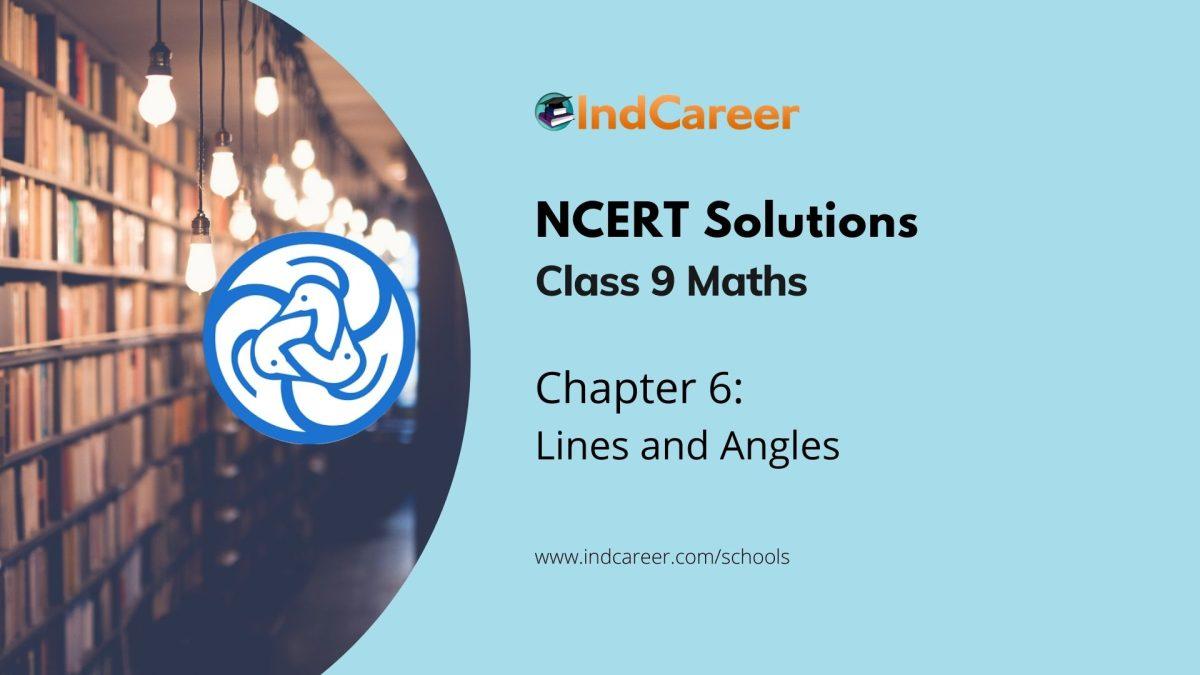Class 9: Maths Chapter 6 solutions. Complete Class 9 Maths Chapter 6 Notes.
Contents
- 1 NCERT Solutions for 9th Class Maths : Chapter 6 Lines and Angles
- 1.0.1 NCERT Solutions for Class 9 Maths Chapters:
- 1.0.2 How many exercises in Chapter 6 Lines and Angles?
- 1.0.3 If the supplement of an angle is 4 times of its complement, find the angle.
- 1.0.4 What is the measure of an angle whose measure is 32° less than its supplement?
- 1.0.5 Angles ∠P and 100° form a linear pair. What is the measure of ∠P?
- 2 NCERT Solutions for 9th Class Maths : Chapter 6: Download PDF
NCERT Solutions for 9th Class Maths : Chapter 6 Lines and Angles
NCERT 9th Maths Chapter 6, class 9 Maths Chapter 6 solutions
Page No: 96
Exercise 6.1
1. In Fig. 6.13, lines AB and CD intersect at O. If ∠AOC + ∠BOE = 70° and ∠BOD = 40°, find ∠BOE and reflex ∠COE.
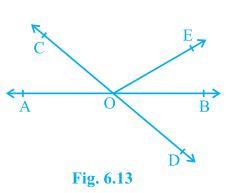
Answer
Given,
∠AOC + ∠BOE = 70° and ∠BOD = 40°
A/q,
∠AOC + ∠BOE +∠COE = 180° (Forms a straight line)
⇒ 70° +∠COE = 180°
⇒ ∠COE = 110°
also,
∠COE +∠BOD + ∠BOE = 180° (Forms a straight line)
⇒ 110° +40° + ∠BOE = 180°
⇒ 150° + ∠BOE = 180°
⇒ ∠BOE = 30°
Page No: 97
2. In Fig. 6.14, lines XY and MN intersect at O. If ∠POY = 90° and a : b = 2 : 3, find c.
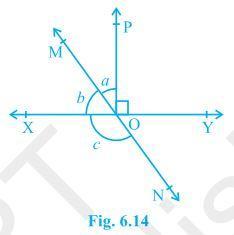
Answer
Given,
∠POY = 90° and a : b = 2 : 3
A/q,
∠POY + a + b = 180°
⇒ 90° + a + b = 180°
⇒ a + b = 90°
Let a be 2x then will be 3x
2x + 3x = 90°
⇒ 5x = 90°
⇒ x = 18°
∴ a = 2×18° = 36°
and b = 3×18° = 54°
also,
b + c = 180° (Linear Pair)
⇒ 54° + c = 180°
⇒ c = 126°
3. In Fig. 6.15, ∠PQR = ∠PRQ, then prove that ∠PQS = ∠PRT.
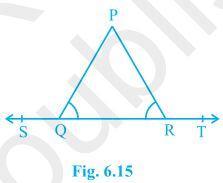
Answer
Given,
∠PQR = ∠PRQ
To prove,
∠PQS = ∠PRT
A/q,
∠PQR +∠PQS = 180° (Linear Pair)
⇒ ∠PQS = 180° – ∠PQR — (i)
also,
∠PRQ +∠PRT = 180° (Linear Pair)
⇒ ∠PRT = 180° – ∠PRQ
⇒ ∠PRQ = 180° – ∠PQR — (ii) (∠PQR = ∠PRQ)
From (i) and (ii)
∠PQS = ∠PRT = 180° – ∠PQR
Therefore, ∠PQS = ∠PRT
4. In Fig. 6.16, if x + y = w + z, then prove that AOB is a line.
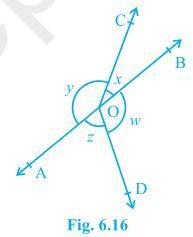
Answer
Given,
x + y = w + z
To Prove,
AOB is a line or x + y = 180° (linear pair.)
A/q,
x + y + w + z = 360° (Angles around a point.)
⇒ (x + y) + (w + z) = 360°
⇒ (x + y) + (x + y) = 360° (Given x + y = w + z)
⇒ 2(x + y) = 360°
⇒ (x + y) = 180°
Hence, x + y makes a linear pair. Therefore, AOB is a staright line.
NCERT 9th Maths Chapter 6, class 9 Maths Chapter 6 solutions
5. In Fig. 6.17, POQ is a line. Ray OR is perpendicular to line PQ. OS is another ray lying between rays OP and OR. Prove that ∠ROS = 1/2(∠QOS – ∠POS).
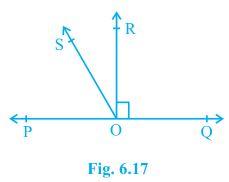
Answer
Given,
OR is perpendicular to line PQ
To prove,
∠ROS = 1/2(∠QOS – ∠POS)
A/q,
∠POR = ∠ROQ = 90° (Perpendicular)
∠QOS = ∠ROQ +
∠ROS = 90° + ∠ROS — (i)
∠POS = ∠POR – ∠ROS = 90° – ∠ROS — (ii)
Subtracting (ii) from (i)
∠QOS – ∠POS = 90° + ∠ROS – (90° – ∠ROS)
⇒ ∠QOS – ∠POS = 90° + ∠ROS – 90° + ∠ROS
⇒ ∠QOS – ∠POS = 2∠ROS
⇒ ∠ROS = 1/2(∠QOS – ∠POS)
Hence, Proved.
6. It is given that ∠XYZ = 64° and XY is produced to point P. Draw a figure from the given information. If ray YQ bisects ∠ZYP, find ∠XYQ and reflex ∠QYP.
Answer
Given,
∠XYZ = 64°
YQ bisects ∠ZYP
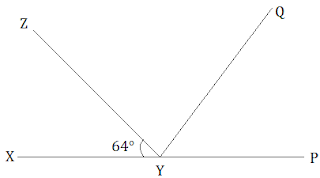
∠XYZ +∠ZYP = 180° (Linear Pair)
⇒ 64° +∠ZYP = 180°
⇒ ∠ZYP = 116°
also, ∠ZYP = ∠ZYQ + ∠QYP
∠ZYQ = ∠QYP (YQ bisects ∠ZYP)
⇒ ∠ZYP = 2∠ZYQ
⇒ 2∠ZYQ = 116°
⇒ ∠ZYQ = 58° = ∠QYP
Now,
∠XYQ = ∠XYZ + ∠ZYQ
⇒ ∠XYQ = 64° + 58°
⇒ ∠XYQ = 122°
also,
reflex ∠QYP = 180° + ∠XYQ
∠QYP = 180° + 122°
⇒ ∠QYP = 302°
Page No: 103
NCERT 9th Maths Chapter 6, class 9 Maths Chapter 6 solutions
Exercise 6.2
1. In Fig. 6.28, find the values of x and y and then show that AB || CD.
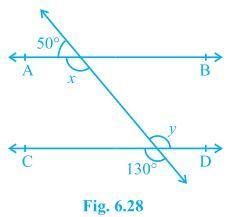
Answer
x + 50° = 180° (Linear pair)
⇒ x = 130°
also,
y = 130° (Vertically opposite)
Now,
x = y = 130° (Alternate interior angles)
Alternate interior angles are equal.
Therefore, AB || CD.
NCERT 9th Maths Chapter 6, class 9 Maths Chapter 6 solutions
Page No: 104
2. In Fig. 6.29, if AB || CD, CD || EF and y : z = 3 : 7, find x.

Answer
Given,
AB || CD and CD || EF
y : z = 3 : 7
Now,
x + y = 180° (Angles on the same side of transversal.)
also,
∠O = z (Corresponding angles)
and, y +
∠O = 180° (Linear pair)
⇒ y + z = 180°
A/q,
y = 3w and z = 7w
3w + 7w = 180°
⇒ 10 w = 180°
⇒ w = 18°
∴ y = 3×18° = 54°
and, z = 7×18° = 126°
Now,
x + y = 180°
⇒ x + 54° = 180°
⇒ x = 126°
3. In Fig. 6.30, if AB || CD, EF ⊥ CD and ∠GED = 126°, find ∠AGE, ∠GEF and ∠FGE.
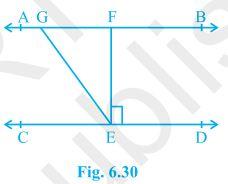
Answer
Given,
AB || CD
EF ⊥ CD
∠GED = 126°
A/q,
∠FED = 90° (EF ⊥ CD)
Now,
∠AGE = ∠GED (Since, AB || CD and GE is transversal. Alternate interior angles.)
∴ ∠AGE = 126°
Also, ∠GEF = ∠GED – ∠FED
⇒ ∠GEF = 126° – 90°
⇒ ∠GEF = 36°
Now,
∠FGE +∠AGE = 180° (Linear pair)
⇒ ∠FGE = 180° – 126°
⇒ ∠FGE = 54°
NCERT 9th Maths Chapter 6, class 9 Maths Chapter 6 solutions
4. In Fig. 6.31, if PQ || ST, ∠PQR = 110° and ∠RST = 130°, find ∠QRS.
[Hint : Draw a line parallel to ST through point R.]
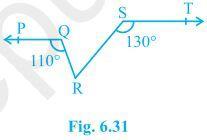
Answer
Given,
PQ || ST, ∠PQR = 110° and ∠RST = 130°
Construction,
A line XY parallel to PQ and ST is drawn.
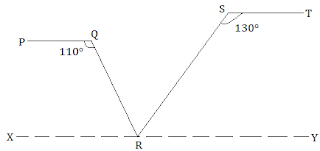
∠PQR + ∠QRX = 180° (Angles on the same side of transversal.)
⇒ 110° + ∠QRX = 180°
⇒ ∠QRX = 70°
Also,
∠RST + ∠SRY = 180° (Angles on the same side of transversal.)
⇒ 130° + ∠SRY = 180°
⇒ ∠SRY = 50°
Now,
∠QRX +∠SRY +
∠QRS = 180°
⇒ 70° + 50° + ∠QRS = 180°
⇒ ∠QRS = 60°
5. In Fig. 6.32, if AB || CD, ∠APQ = 50° and ∠PRD = 127°, find x and y.
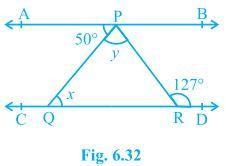
Answer
Given,
AB || CD, ∠APQ = 50° and ∠PRD = 127°
A/q,
x = 50° (Alternate interior angles.)
∠PRD + ∠RPB = 180° (Angles on the same side of transversal.)
⇒ 127° + ∠RPB = 180°
⇒ ∠RPB = 53°
Now,
y + 50° + ∠RPB = 180° (AB is a straight line.)
⇒ y + 50° + 53° = 180°
⇒ y + 103° = 180°
⇒ y = 77°
NCERT 9th Maths Chapter 6, class 9 Maths Chapter 6 solutions
6. In Fig. 6.33, PQ and RS are two mirrors placed parallel to each other. An incident ray AB strikes the mirror PQ at B, the reflected ray moves along the path BC and strikes the mirror RS at C and again reflects back along CD. Prove that AB || CD.
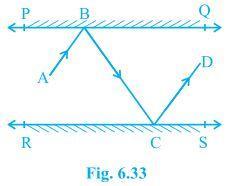
Answer
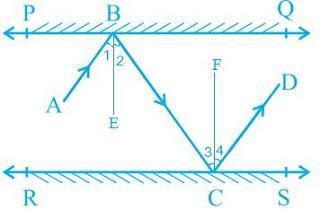
Let us draw BE ⟂ PQ and CF ⟂ RS.
As PQ || RS
So, BE || CF
By laws of reflection we know that,
Angle of incidence = Angle of reflection
Thus, ∠1 = ∠2 and ∠3 = ∠4 — (i)
also, ∠2 = ∠3 (alternate interior angles because BE || CF and a transversal line BC cuts them at B and C) — (ii)
From (i) and (ii),
∠1 + ∠2 = ∠3 + ∠4
⇒ ∠ABC = ∠DCB
⇒ AB || CD (alternate interior angles are equal)
Page No: 107
NCERT 9th Maths Chapter 6, class 9 Maths Chapter 6 solutions
Exercise 6.3
1. In Fig. 6.39, sides QP and RQ of ΔPQR are produced to points S and T respectively. If ∠SPR = 135° and ∠PQT = 110°, find ∠PRQ.
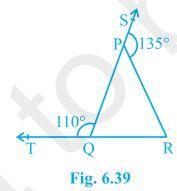
Answer
Given,
∠SPR = 135° and ∠PQT = 110°
A/q,
∠SPR +∠QPR = 180° (SQ is a straight line.)
⇒ 135° +∠QPR = 180°
⇒ ∠QPR = 45°
also,
∠PQT +∠PQR = 180° (TR is a straight line.)
⇒ 110° +∠PQR = 180°
⇒ ∠PQR = 70°
Now,
∠PQR +∠QPR + ∠PRQ = 180° (Sum of the interior angles of the triangle.)
⇒ 70° + 45° + ∠PRQ = 180°
⇒ 115° + ∠PRQ = 180°
⇒ ∠PRQ = 65°
2. In Fig. 6.40, ∠X = 62°, ∠XYZ = 54°. If YO and ZO are the bisectors of ∠XYZ and ∠XZY respectively of Δ XYZ, find ∠OZY and ∠YOZ.
Answer
Given,
∠X = 62°, ∠XYZ = 54°
YO and ZO are the bisectors of ∠XYZ and ∠XZY respectively.
A/q,
∠X +∠XYZ +
∠XZY = 180° (Sum of the interior angles of the triangle.)
⇒ 62° + 54° + ∠XZY = 180°
⇒ 116° + ∠XZY = 180°
⇒ ∠XZY = 64°
Now,
∠OZY = 1/2∠XZY (ZO is the bisector.)
⇒ ∠OZY = 32°
also,
∠OYZ = 1/2∠XYZ (YO is the bisector.)
⇒ ∠OYZ = 27°
Now,
∠OZY +∠OYZ +
∠O = 180° (Sum of the interior angles of the triangle.)
⇒ 32° + 27° + ∠O = 180°
⇒ 59° + ∠O = 180°
⇒ ∠O = 121°
3. In Fig. 6.41, if AB || DE, ∠BAC = 35° and ∠CDE = 53°, find ∠DCE.
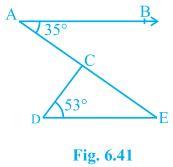
Answer
Given,
AB || DE, ∠BAC = 35° and ∠ CDE = 53°
A/q,
∠BAC = ∠CED (Alternate interior angles.)
∴ ∠CED = 35°
Now,
∠DCE +∠CED + ∠CDE = 180° (Sum of the interior angles of the triangle.)
⇒ ∠DCE + 35° + 53° = 180°
⇒ ∠DCE + 88° = 180°
⇒ ∠DCE = 92°
4. In Fig. 6.42, if lines PQ and RS intersect at point T, such that ∠PRT = 40°, ∠RPT = 95° and ∠TSQ = 75°, find ∠SQT.
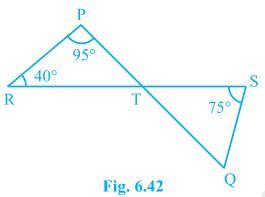
Answer
Given,
∠PRT = 40°, ∠RPT = 95° and ∠TSQ = 75°
A/q,
∠PRT +∠RPT + ∠PTR = 180° (Sum of the interior angles of the triangle.)
⇒ 40° + 95° + ∠PTR = 180°
⇒ 40° + 95° + ∠PTR = 180°
⇒ 135° + ∠PTR = 180°
⇒ ∠PTR = 45°
∠PTR = ∠STQ = 45° (Vertically opposite angles.)
Now,
∠TSQ +∠PTR +
∠SQT = 180° (Sum of the interior angles of the triangle.)
⇒ 75° + 45° + ∠SQT = 180°
⇒ 120° + ∠SQT = 180°
⇒ ∠SQT = 60°
NCERT 9th Maths Chapter 6, class 9 Maths Chapter 6 solutions
Page No: 108
5. In Fig. 6.43, if PQ ⊥ PS, PQ || SR, ∠SQR = 28° and ∠QRT = 65°, then find the values of x and y.
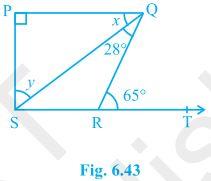
Answer
Given,
PQ ⊥ PS, PQ || SR, ∠SQR = 28° and ∠QRT = 65°
A/q,
x +∠SQR = ∠QRT (Alternate angles as QR is transveersal.)
⇒ x + 28° = 65°
⇒ x = 37°
also,
∠QSR = x
⇒ ∠QSR = 37°
also,
∠QRS +∠QRT = 180° (Linea pair)
⇒ ∠QRS + 65° = 180°
⇒ ∠QRS = 115°
Now,
∠P +
∠Q+ ∠R +
∠S = 360° (Sum of the angles in a quadrilateral.)
⇒ 90° + 65° + 115° + ∠S = 360°
⇒ 270° + y + ∠QSR = 360°
⇒ 270° + y + 37° = 360°
⇒ 307° + y = 360°
⇒ y = 53°
6. In Fig. 6.44, the side QR of ΔPQR is produced to a point S. If the bisectors of ∠PQR and ∠PRS meet at point T, then prove that ∠QTR = 1/2∠QPR.
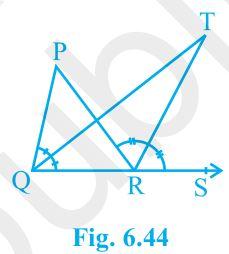
Answer
Given,
Bisectors of ∠PQR and ∠PRS meet at point T.
To prove,
∠QTR = 1/2∠QPR.
Proof,
∠TRS = ∠TQR +
∠QTR (Exterior angle of a triangle equals to the sum of the two interior angles.)
⇒ ∠QTR = ∠TRS – ∠TQR — (i)
also,
∠SRP = ∠QPR +
∠PQR
⇒ 2∠TRS = ∠QPR + 2∠TQR
⇒ ∠QPR = 2∠TRS – 2∠TQR
⇒ 1/2∠QPR = ∠TRS – ∠TQR — (ii)
Equating (i) and (ii)
∠QTR – ∠TQR = 1/2∠QPR
Hence proved.
Chapter 6 Lines and Angles is a great chapter which must be in your strategy to improve your marks in geometry section. You will learn variety of new terms and definitions which are going to help in solving questions.
• Basic Terms and Definitions: A part of a line with two end points is called a line-segment and a part of a line with one end point is called a ray. If three or more points lie on the same line, they are called collinear points otherwise they are called non-collinear points. An angle is formed when two rays originate from the same end point. The rays making an angle are called the arms of the angle and the end point is called the vertex of the angle.
An acute angle measures between 0° and 90°, whereas a right angle is exactly equal to 90°. An angle greater than 90° but less than 180° is called an obtuse angle. A straight angle is equal to 180°. An angle which is greater than 180° but less than 360° is called a reflex angle. Two angles whose sum is 90° are called complementary angles, and two angles whose sum is 180° are called supplementary angles. Two angles are adjacent, if they have a common vertex, a common arm and their non-common arms are on different sides of the common arm.
• Intersecting Lines and Non-intersecting Lines: If two lines intersect each other, then the vertically opposite angles are equal.
• Pairs of Angles: There is a very important theorem is given in this section. On the basis of which you have to solve questions given in the exercise 6.1 If two lines intersect each other, then the vertically opposite angles are equal.
• Parallel Lines and a Transversal: There are four theorems given in this section which is to going to help you in solving questions effectively.
(i) If a transversal intersects two parallel lines, then each pair of alternate interior angles is equal.
(ii) If a transversal intersects two lines such that a pair of alternate interior angles is equal, then the two lines are parallel.
(iii) If a transversal intersects two parallel lines, then each pair of interior angles on the same side of the transversal is supplementary.
(iv) If a transversal intersects two lines such that a pair of interior angles on the same side of the transversal is supplementary, then the two lines are parallel.
• Lines Parallel to the Same Line: Lines which are parallel to the same line are parallel to each other.
• Angle Sum Property of a Triangle: (i) The sum of the angles of a triangle is 180º. (ii) If a side of a triangle is produced, then the exterior angle so formed is equal to the sum of the two interior opposite angles.
Three exercises are given in Chapter 6 Lines and Angles NCERT Solutions which will improve your knowledge of Geometry. Every students must try to solve each questions given in the exercise that is why we have also provided exercise wise solutions of every problem that you can find below.
Indcareer Schools experts at every step, they have tried to prepare these Class 9 Maths NCERT Solutions in such a way that you can easily understand even the most difficult problems. You can always clear related to this chapter just by visiting this page.
NCERT Solutions for Class 9 Maths Chapters:
FAQ on Chapter 6 Lines and Angles
How many exercises in Chapter 6 Lines and Angles?
There are only three exercise in Chapter 6 Lines and Angles NCERT Solutions which are also important for competitive exams and higher grades. We have detailed every step through which one can always clear their doubts.
If the supplement of an angle is 4 times of its complement, find the angle.
Let the required angle be x
∴ (180°- x) = 4 (90° – x)
⇒ x = 60°
What is the measure of an angle whose measure is 32° less than its supplement?
Let the required angle be x
∴ x = (180°- x) – 32°
⇒ x = 74°
Angles ∠P and 100° form a linear pair. What is the measure of ∠P?
Since, the sum of the angles of a linear pair equal to 180°.
∴ ∠ P + 100° = 180°
⇒ ∠ P = 180° – 100 = 80°.
NCERT 9th Maths Chapter 6, class 9 Maths Chapter 6 solutions
NCERT Solutions for 9th Class Maths : Chapter 6: Download PDF
NCERT Solutions for 9th Class Maths : Chapter 6 Lines and Angles
Download PDF: NCERT Solutions for 9th Class Maths : Chapter 6 Lines and Angles PDF
Chapterwise NCERT Solutions for Class 9 Maths :
- Chapter 1 Number System
- Chapter 2 Polynomials
- Chapter 3 Coordinate Geometry
- Chapter 4 Linear Equations in Two Variables
- Chapter 5 Introduction to Euclid’s Geometry
- Chapter 6 Lines and Angles
- Chapter 7 Triangles
- Chapter 8 Quadrilaterals
- Chapter 9 Areas of Parallelograms and Triangles
- Chapter 10 Circles
- Chapter 11 Constructions
- Chapter 12 Heron’s Formula
- Chapter 13 Surface Areas and Volumes
- Chapter 14 Statistics
- Chapter 15 Probability
About NCERT
The National Council of Educational Research and Training is an autonomous organization of the Government of India which was established in 1961 as a literary, scientific, and charitable Society under the Societies Registration Act. Its headquarters are located at Sri Aurbindo Marg in New Delhi. Visit the Official NCERT website to learn more.
